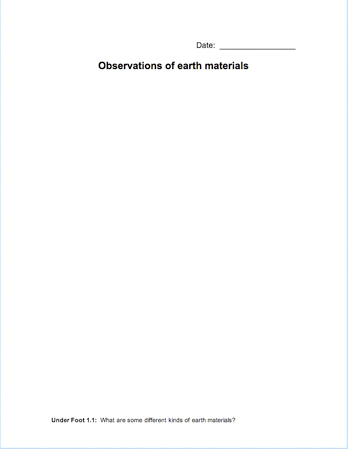What are some different kinds of earth materials?
Plan Investigation 1.1
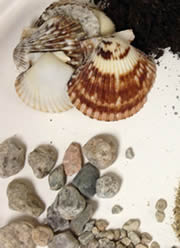
What's underfoot? Carpet... wood... grass... sand... water? As we go about our daily lives, we seldom think about what's underfoot - unless we literally stumble across something new. In this study we "bring the outside in" to learn more about some of the natural materials that occur at or near Earth's surface. Students begin by imagining what they would find under their feet at various locations on Earth's surface and start to generate a list of materials they consider Earth materials. They then explore a small collection of common earth materials. Finally they gather to discuss the results, add to the list of Earth materials, and consolidate their ideas.
By the end of the investigation, students will have hands-on experience with common earth materials, including gravel, sand, clay, shells, organic soil, water, and oil. They will consider what might and might not be an earth material.
Learning Goals
- Become familiar with a variety of common earth materials
| Sequence of experiences | ||
|---|---|---|
| 1. Introduce the unit | All Class | 5 Mins |
| 2. Elicit ideas | Discussion | 15 Mins |
| 3. Explore earth materials | Small Groups | 15 Mins |
| 4. Make meaning | Discussion | 10 Mins |
Materials and Preparation
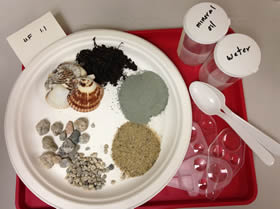
- Post the investigation question in a place where all students can see it.
- Student notebooks
- A large sheet of paper for recording a list of earth materials
- 1 plate of earth materials containing approximately 20cc each of gravel, sand, clay, organic soil, pebbles, and shells, arranged in piles
- 1 capped 150cc container with exactly 40cc of fresh water**
- 1 capped 150cc container with exactly 40cc of mineral oil**
- 4 magnifying glasses
- 4 plates
Note: The clay is not in the familiar moist, malleable form that students will recognize. All of the water has been removed, and just the tiny dry particles of clay remain. Its form is now more like a powder.
About mineral oil: Like corn oil and olive oil, the mineral oil that students will investigate today began as vegetal matter. But this oil was formed millions of years ago and it was trapped under ground for most of that time, causing it to change. The mineral oil has been refined; parts of the original oil have been separated and removed, so it is cleaner, but it still has most of its original properties. The products sold as "baby oil" are typically mineral oil.
* You may need to adjust the groups to suit your class size and configuration.
** These containers are used again in Investigation 2.1.
Notebook Pages
1. Introduce the new science unit
Tell students they will start a new science topic today, about earth materials. In each session, they will have a new question to investigate that will help them to understand more about earth materials.
Letter from the Engineer
You may know something about the work that scientists do. Some study the stars and planets. Some study the different plants and animals on Earth. Some study the non-living parts of Earth, such as the rocks, ice, and oceans. All scientists study the natural world to learn more about how it works. They notice changes and they try to understand why the changes are happening. They ask questions, and they often work with other scientists to try to find the answers. For example, scientists might ask, “Why did the birds that use to come here every summer stop coming? What happened? What is different now?” Scientists can spend years trying to answer their own questions. They make careful observations, they take notes, and they work to make sense of the information or data they have collected.
Scientists sometimes work with engineers, but the main job of an engineer is different than the scientist’s. The main job of an engineer is to solve problems, usually to provide people with something they need or want. Engineers also ask themselves questions, but their questions are about the problems they solve. They ask, “How can we build a car that uses less gasoline?” or “How can we build a robot that will help scientists explore Mars?” Engineers also study the materials that are used to make objects. They might ask, “Will this object work better if it is made from plastic or made from wood?” or “How can we make this glass stronger, so if something hits it, it will not break?”
In your investigations you will be thinking like a scientist most of the time, but there will also be times when you will need to think like an engineer, and solve problems that will then help you to learn more about the natural world.
Look for more Letters from the Engineer. These will point out some of the times when thinking like an engineer is important.
2. Elicit ideas
Purpose of the discussion:
The purpose of this discussion is for students to become familiar with their own ideas about earth materials and to broaden their ideas by actively listening to others. The focus question for the discussion is: What earth materials are under your feet?
Engage students in the focus question
Ask students to think about places where Earth's surface is not hidden by sidewalks, streets, buildings, or other human–made objects. Provide examples: a beach, or a park. These are places where Earth's natural surface is visible.
Ask students to provide other examples (e.g., a garden, a ball field, a dirt road, a back yard, a field at a summer camp, a mountain trail, an ocean).
Invite students to pick one of those places, close their eyes, and imagine they are standing there barefoot.
Provide time for students to collect their thoughts.
Where are you? What earth materials are under your feet?
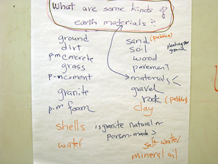
Record student responses (e.g., dirt, rocks, dead leaves, twigs, mud, sand, puddles).
Accept all suggestions without hesitation or passing judgment. A key purpose of this discussion is to engage students personally in the new investigation by welcoming their contributions. Students will have an opportunity to revisit the list later in the class, once they have explored some earth materials and have had more time to reflect on this new topic.
Note: Scientists do not include manufactured objects or living animals or plants as earth materials. They do consider dead or decomposed animals or plants as earth materials, along with rocks, sand, gravel, water, and other natural, non-manufactured materials. Do not share the scientists' definition of earth materials with students at this time. That can happen once they revisit the list they have generated, closer to the end of the session.
Demonstrate active listening and engagement by helping students build on and connect ideas, ask questions or make observations.
Summarize the discussion
Remind students that they started thinking about earth materials by imagining what might be under their feet in different places on Earth's surface, and came up with a class list. They will have time to suggest or debate changes to the list later. Explain that we might discover something else about the kinds of earth materials by closely observing some. So, the question we'll investigate today is:
What are some different kinds of earth materials?
3. Explore earth materials
Introduce the science notebooks
Remind students that they will have a question to investigate in each session of the new science unit, and they will have a science notebook to record their observations and ideas. Hand out the science notebooks. Explain that all scientists have notebooks, where they record their observations, jot down their questions, make drawings, and record their ideas. The students will do the same thing; in fact, the first thing students will do in every science class is get out their notebooks.
Have the students write their name on their notebook, then find the first notebook page [Observations of earth materials], and record today's date. Take a few seconds to explain why it's important to date scientific observations.
Restate the investigation question
What are some different kinds of earth materials?
Explore
Provide each group with a tray of materials. Not all students will be able to identify all of the materials on the tray, so spend a few minutes helping them with that so everyone will be able to communicate effectively. The clay, in particular, is not in a form that students are likely to recognize.
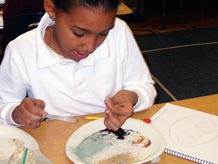
Ask students to take small samples of the solid materials, place them on their individual paper plates, and examine them using the magnifiers. They should keep the liquid containers closed.
- What do you see?
- How do the materials compare?
- What words can you use to describe them?
As you circulate among the groups, ask students to record their observations in their notebooks [Observations of earth materials] using both words and drawings.
Emphasize the importance of careful observation and record keeping. Let students know that the correct term for the information they have recorded is data.
Data is the record of all observations. Data can be words, or drawings, or photographs, or measurements – or all of these. Data is the basis of all scientific understanding.
4. Make meaning
Purpose of the discussion
The purpose of the discussion is to consolidate students' growing awareness of the natural earth materials. Return to the investigation question for the discussion.
Engage students in the focus question
Remind students of the investigation question.
What are some different kinds of earth materials?
Now that students have explored some earth materials, are they convinced that everything on the class list is an earth material, a part of the natural earth? Do they have new things to add, as a result of having explored some earth materials? Are there things they think should be removed from the list?
Return to any challenges students may have posed as the class developed the list, regarding the inclusion of manufactured objects (e.g., buttons, concrete) or living animals or plants. If no one has questioned the inclusion of these on the list, do so now. For example:
If there are several living things on the list (e.g., grass, worms, small mammals), include them as a group.
Listen as students share their thoughts and ask them to explain the reasoning behind their thinking. Through this process they may come to the conclusion that earth materials should not include living things or manufactured objects.
Share the scientists' definition
Explain that scientists have also thought about this same question, and have decided that earth materials include the natural materials that are not alive and that have not been manufactured by humans (so, no concrete or buttons that we may find beneath our feet). After living animals and plants have died and have started to decay, scientists do consider them to be earth materials. So pieces of dead insects, dead leaves and pieces of wood, are included along with water, rocks, sand, gravel, and other natural earth materials.
Students are likely to have suggested "dirt" as an earth material. Now is the time to replace the term "dirt" with the term "soil", explaining that this is the term that scientists use.
Summarize the discussion and recap the investigation
Students’ responses to the questions below will serve as a summary.
- What do you know now about earth materials that you didn't know before?
- What did you learn today that surprised you?
Acknowledge that students have refined a list of earth materials, and have started to investigate eight of those materials: pebbles, gravel, sand, clay, shells, organic soil, water, and oil. Explain they will continue to investigate these eight materials and some new ones in the upcoming weeks.
Students have also started to record information called data in their science notebooks. Those notebooks will be an important part of the science unit over the next several weeks.


